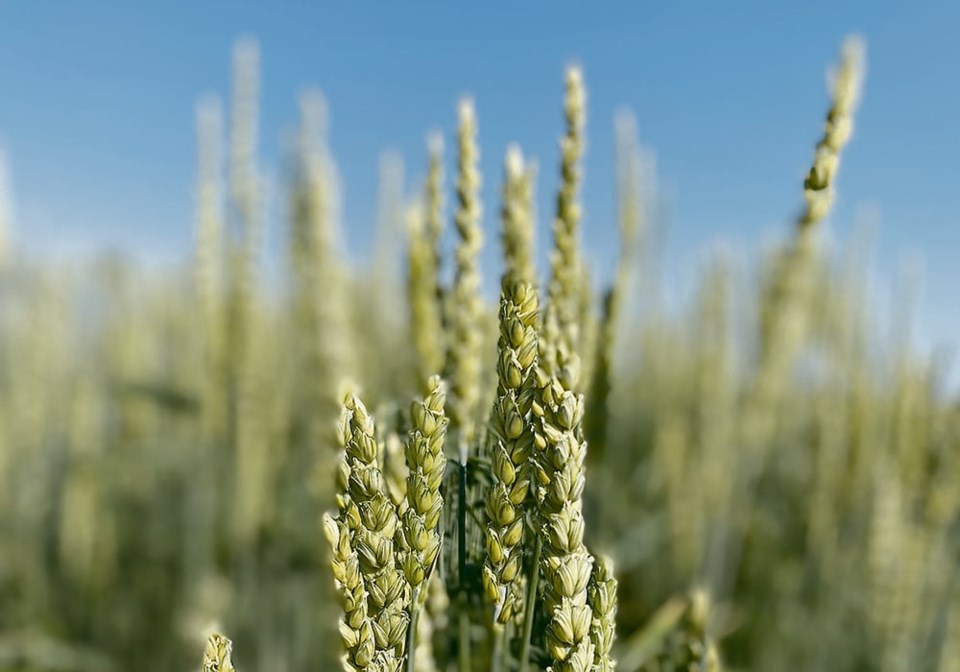WESTERN PRODUCER — It takes a lot of math to grow a high-bushel wheat crop — number of heads, spikelets per head, grains per spikelet and more.
However, Phil Needham said spending some time thinking about these and quantifying them can help growers get the best from their seeds.
The U.K.-born, U.S.-based agronomist told the SaskWheat semi-annual meeting in Regina last month that starting with good quality, uniform seed and planting in narrow rows help develop the crop canopy needed to ensure yield.
The idea is to produce a main stem and one tiller, which in turn produce the bulk of the yield.
If we can generate 60 to 70 percent of the yield from the main stems, that’s what we want to do,” he said.
Most farmers should aim for 500 to 600 heads per sq. yard. Needham advised walking fields with a tape measure.
“If you haven’t physically got enough heads per sq. yard, or per sq. metre, you’re not going to capture full yield potential,” he said.
Needham said he thinks a lot of growers are planting wheat too early into good moisture with a lot of nitrogen down at that time. The result is too many tillers per plant and lodging.
“We’ve found that (lodging) reduces the yield of a crop about one percent for every day that crop is lodged between the day it lodges and the day it starts to dry down,” he said.
“So if it lodges 30 days before it begins to dry down, then that’s about a 30 percent yield reduction.”
He suggested reducing the seeding rate if seeding early in warm conditions.
Needham showed a photograph analyzing stems in a 50 bushel per acre wheat field.
Nine percent of the stems had no grain at all, while 28 percent had 10 grains, 48 percent had more than 20 and 15 percent had more than 30 grains per head.
He compared that to a 105 bu. field in which 39 percent of the main stems had 35 grains per head, 35 percent had 20 from the main stem and one tiller, 19 percent had less than 10 grains and seven percent had none.
“This is where a higher yield platform would begin,” he said.
“You want to get most of the yield potential in the main stem and the first tiller.
He wouldn’t push the head counts beyond 500 to 600 no matter the variety or class of wheat, noting that even in New Zealand where farmers have produced 200 to 250 bu. wheat in contests, they only have that many.
“Your head size, especially on the main stems and primary tillers, have a lot more spikelets, so that’s where your yield is coming from,” he said.
Needham also addressed fertilizer, saying that higher nitrogen placement at seeding creates very dense canopies and up to 1,000 heads per sq. yard. Lodging will result and yield will decrease.
He doesn’t recommend placing all nitrogen at once because moisture conditions are uncertain. Instead, he said applying 50 or 60 pounds at seeding and then top dressing at jointing ahead of a rain provides greater yield potential.
Fertilizer can create a toxic zone around a seed, and Needham said an inch between the seed and a urea prill or anhydrous band is recommended.
Needham stressed uniformity throughout, from seeding to emergence to harvest.
He said a wheat stand should resemble a picket fence, but instead fields are often variable. That can begin with different seed sizes and vigour.
“Treating seed uniformly or getting a good average seed size for planting really don’t cost a lot of money,” he said.
“Little things can add up.”
The goal is to generate a canopy that is consistent as possible.
He suggested growers use an app such as Canopio, which will, when held above the crop, generate a leaf canopy percentage.
“Most research from around the world will show that spring cereals in general need to be 75 or 80 percent at least leaf area coverage on the soil surface at around the jointing stage,” Needham said.
“I know some of you are wanting to go to 10, 12-inch wide rows, which in effect will reduce the coverage in this app, and that’s a yield reduction.”




